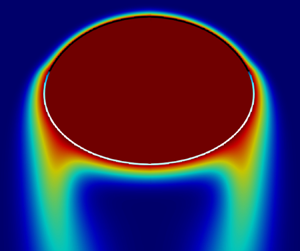No CrossRef data available.
Article contents
Impact of surfactants on the rise of deformable bubbles and interfacial gas–liquid mass transfer
Published online by Cambridge University Press: 29 August 2023
Abstract

Axisymmetric numerical simulations of the hydrodynamics around rising bubbles are performed in order to investigate the impact of surfactants on the bubble dynamics. Surfactants are assumed to be insoluble. The transport of the adsorbed surfactants is computed along the deforming surface at large surface Péclet number, and Marangoni stresses are taken into account. This simulation model leads to the stagnant-cap regime, with partially immobile interfaces. A parametric study is performed on cases at given Archimedes number, by varying the degree of contamination (Marangoni number) but maintaining a nearly constant Eötvös number. The presence of surfactants affects the rise velocity for oblate bubbles less than for spherical bubbles: the increase of the drag coefficient, due to interface contamination, is mitigated by a lower bubble deformation. When the cap angle  $\theta _{cap}$ belongs to the southern hemisphere, the aspect ratio
$\theta _{cap}$ belongs to the southern hemisphere, the aspect ratio  $\chi$ is found to decrease with contamination: the dynamic pressure responsible for the bubble distortion is lowered, related to the decline of kinetic energy. As soon as
$\chi$ is found to decrease with contamination: the dynamic pressure responsible for the bubble distortion is lowered, related to the decline of kinetic energy. As soon as  $\theta _{cap}$ lies in the northern hemisphere, the pressure stress causing distortion becomes independent on
$\theta _{cap}$ lies in the northern hemisphere, the pressure stress causing distortion becomes independent on  $\theta _{cap}: \chi$ no longer evolves with contamination, and already matches the prediction for fully immobile interfaces. Mass transfer of a passive scalar across the contaminated interface is also analysed. Surprisingly, the Sherwood number
$\theta _{cap}: \chi$ no longer evolves with contamination, and already matches the prediction for fully immobile interfaces. Mass transfer of a passive scalar across the contaminated interface is also analysed. Surprisingly, the Sherwood number  $Sh$ is found to follow the same law as for spherical shapes (Kentheswaran et al., Intl J. Heat Mass Transfer, vol. 198, 2022, 123325), allowing us to predict the decrease in
$Sh$ is found to follow the same law as for spherical shapes (Kentheswaran et al., Intl J. Heat Mass Transfer, vol. 198, 2022, 123325), allowing us to predict the decrease in  $Sh$ due to contamination. These results reveal the couplings between interface immobilisation, bubble deformation, rise velocity and interfacial mass transfer.
$Sh$ due to contamination. These results reveal the couplings between interface immobilisation, bubble deformation, rise velocity and interfacial mass transfer.
- Type
- JFM Papers
- Information
- Copyright
- © The Author(s), 2023. Published by Cambridge University Press





